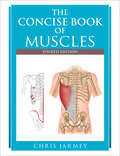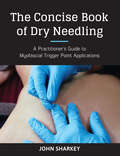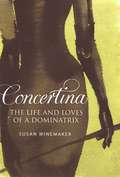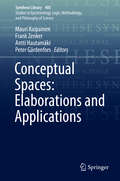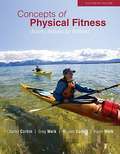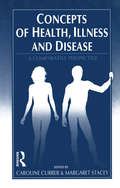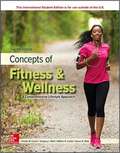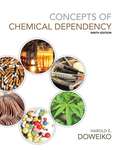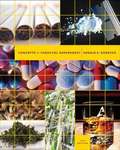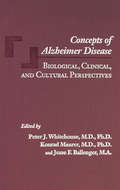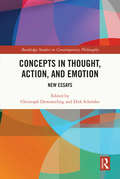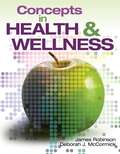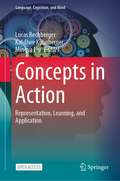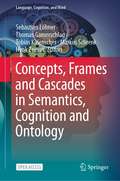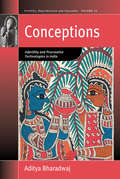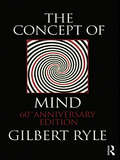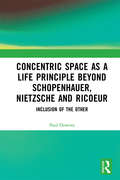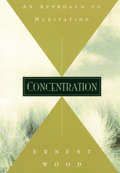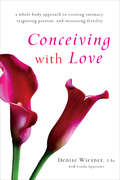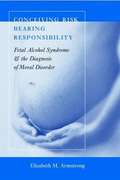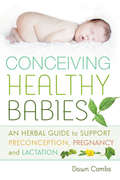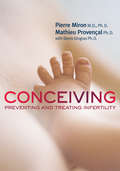- Table View
- List View
The Concise Book of Muscles, Fourth Edition
by Chris JarmeyUpdated to include quick reference tables, an overview of the gross anatomy of the body area and the nerve pathways that are most relevant, and a new chapter on the pelvic floor muscles, the fourth edition of this authoritative, best-selling book offers a comprehensive introduction to the muscular system.This newly revised fourth edition of The Concise Book of Muscles is a comprehensive guide to the major muscle groups. Fully illustrated with more than 500 drawings, and easy to use, this compact reference provides a complete profile for each muscle, clearly showing its origin, insertion, nerve supply, and action, the movements that use it, and, where appropriate, exercises that stretch and strengthen it.The book's distinctive quick-reference format shows students exactly how to locate and identify specific muscles, highlighting those that are heavily used and therefore subject to injury in a variety of sports and activities. Each muscle chapter now includes an overview of the gross anatomy of the body area to show bony landmarks, cross-sections of muscle layers, and points of attachment as well as a quick reference table and an overview of the nerve pathways that are most relevant. The book also includes a new chapter on the pelvic floor muscles--of particular interest to those studying or practicing yoga and Pilates--as well as a 20"x35" detachable muscle wall chart. While designed for the student and beginning practitioner of anatomy, massage, bodywork, physical therapy, chiropractic medicine, physiotherapy, yoga, and Pilates or any other health-related field, The Concise Book of Muscles is equally useful for athletes and anyone interested in the workings of the human body.
The Concise Book of Dry Needling: A Practitioner's Guide to Myofascial Trigger Point Applications
by John SharkeyA major development in the safe and effective treatment of myofascial trigger points and myofascial pain, this book is a concise, comprehensive, and well-illustrated reference on dry needling. John Sharkey—an international authority on myofascial trigger points, myofascial pain, myofascial trigger point dry needling, and neuromuscular therapy as well as an accredited clinical anatomist—draws on his thirty years of experience in bodywork and movement therapy to provide accurate and essential criteria for the identification and subsequent treatment of myofascial trigger points through the exclusive use of a fine, filiform needle. The ideal accompaniment to course notes and the perfect tableside reference guide, this book describes the origin, etiology, and pathophysiology of the myofascial trigger point as well as indications and contraindications for myofascial trigger point dry needling. Instructive illustrations support the text, along with standards and guidelines that ensure safe, effective, and appropriate application. Physical therapists including osteopaths, chiropractors, neuromuscular therapists, soft tissue therapists, physiotherapists, and sports massage therapists will find this guide indispensible. Because Sharkey explains why so many people have unresolved chronic pain and provides clear explanations of how pain is propagated, the book is also an invaluable source of information for patients with chronic pain and their care providers.From the Trade Paperback edition.
Concertina: The Life and Loves of a Dominatrix
by Susan WinemakerWhat happens when a professional chef becomes a dominatrix, swapping the heat of the kitchen for the intensity of a dungeon? A memoir in three parts, Concertina spans five years of the author's life as she makes the extraordinary transition from culinary expert to professional dominatrix. Taking the reader into the secret, hidden world of suburban sado-masochism, Winemaker introduces us to a fascinating array of colourful characters, before she breaks the code of domination: falling in love with a client. Honest, brave and beautifully written, Concertina is a memoir that finds passion and tenderness in the most unlikely places.
Conceptual Spaces: Elaborations and Applications (Synthese Library #405)
by Peter Gärdenfors Frank Zenker Mauri Kaipainen Antti HautamäkiThis edited book focuses on concepts and their applications using the theory of conceptual spaces, one of today’s most central tracks of cognitive science discourse. It features 15 papers based on topics presented at the Conceptual Spaces @ Work 2016 conference. The contributors interweave both theory and applications in their papers. Among the first mentioned are studies on metatheories, logical and systemic implications of the theory, as well as relations between concepts and language. Examples of the latter include explanatory models of paradigm shifts and evolution in science as well as dilemmas and issues of health, ethics, and education. The theory of conceptual spaces overcomes many translational issues between academic theoretization and practical applications. The paradigm is mainly associated with structural explanations, such as categorization and meronomy. However, the community has also been relating it to relations, functions, and systems. The book presents work that provides a geometric model for the representation of human conceptual knowledge that bridges the symbolic and the sub-conceptual levels of representation. The model has already proven to have a broad range of applicability beyond cognitive science and even across a number of disciplines related to concepts and representation.
The Conceptual Representation of Consciousness
by Thomas NatsoulasConsciousness is familiar to us first hand, yet difficult to understand. This book concerns six basic concepts of consciousness exercised in ordinary English. The first is the interpersonal meaning and requires at least two people involved in relation to one another. The second is a personal meaning, having to do with one's own perspective on the kind of person one is and the life one is leading. The third meaning has reference simply to one's being occurrently aware of something or as though of something. The fourth narrows the preceding sense to one's having direct occurrent awareness of happenings in one's own experiential stream. The fifth is the unitive meaning of consciousness and has reference to those portions of one's stream that one self-appropriates to make up one's conscious being. The last is the general-state meaning and picks out the general operating mode in which we most often function.
Concepts of Physical Fitness: Active Lifestyles for Wellness
by Charles B. Corbin Gregory J. Welk William R. Corbin Karen A. Welk Cara L. SidmanA proven philosophy for teaching lifetime fitness and wellness... the HELP philosophy: “Health is available to Everyone for a Lifetime, and it’s Personal.”
Concepts of Health, Illness and Disease: A Comparative Perspective
by Caroline CurrerBoth health care practitioners and health planners are beginning to recognize the importance of differences between lay and professional concepts of health and illness. The editors of this volume, having themselves worked in this field for many years, have selected and brought together writings by distinguished scholars from Britain, France, the United States, Germany and Poland. What impresses most is the range of problems synthesized from a genuinely international and interdisciplinary perspective. No reader can fail to be fascinated by the often peculiar ways in which different societies have tried to cope with the existential questions of health and illness.
Concepts of Fitness and Wellness: A Comprehensive Lifestyle Approach
by Charles B. CorbinConcepts of Fitness & Wellness provides readers with the self-management skills necessary to adopt a healthy lifestyle. A pioneering text in the field, Concepts of Fitness & Wellness is designed to deliver a comprehensive text and digital program that continues to be at the cutting edge of physical activity and health promotion, empowering students to make positive steps towards developing a lifelong commitment to being active. The fully updated eleventh edition is supported by Connect, the only integrated digital learning environment that empowers students by continuously adapting to deliver precisely what they need, when they need it, so that your class time is more engaging and effective.
Concepts of Chemical Dependency (Ninth Edition)
by Harold E. DoweikoCONCEPTS OF CHEMICAL DEPENDENCY, Ninth Edition, provides comprehensive coverage and the latest information on a full spectrum of substance use disorders and the compounds commonly abused. Topics include the abuse of and addiction to alcohol; how the active agent in marijuana, THC, affects neural growth and development; the emerging body of evidence suggesting a relationship between marijuana abuse and psychotic disorders; the emerging body of evidence suggesting that marijuana is not as benign as it was thought to be a few years ago; and the abuse of cough syrups. Adding to the book's usefulness and relevance, Doweiko also covers topics not usually discussed in other substance abuse texts, including abuse of anabolic steroids, inhalants, infectious diseases associated with substance abuse, how the "war on drugs" has actually contributed to the problem of substance abuse/addiction in this country, and the "medical marijuana" debate. This edition includes new information on synthetic marijuana, mephredone, and dextromethorphan, among other substances; updates reflecting the new DSM-5; and a new chapter on the Biopsychosocial Model of Addiction. Students report that they appreciate the author's balanced approach, which allows them to form their own opinions, in contrast to some books that "preach" that "drugs are bad for you."
Concepts of Chemical Dependency (7th edition)
by Harold E. DoweikoIncorporating the science, sociology, and criminology behind addiction and its treatment, this textbook introduces basic facts about substance abuse and addiction in the US, describes the physical and social effects of particular drugs, and presents strategies for evaluation, intervention, and recovery. The sixth edition adds two closing chapters on legalization and criminal behavior.
Concepts of Alzheimer Disease: Biological, Clinical, and Cultural Perspectives (Gerontology)
by Peter J. Whitehouse Konrad Maurer Jesse F. BallengerAs the essays in this volume show, conceptualizing dementia has always been a complex process. With contributions from noted professionals in psychiatry, neurology, molecular biology, sociology, history, ethics, and health policy, Concepts of Alzheimer Disease looks at the ways in which Alzheimer disease has been defined in various historical and cultural contexts.The book covers every major development in the field, from the first case described by Alois Alzheimer in 1907 through groundbreaking work on the genetics of the disease. Essays examine not only the prominent role that biomedical and clinical researchers have played in defining Alzheimer disease, but also the ways in which the perspectives of patients, their caregivers, and the broader public have shaped concepts.
Concepts in Thought, Action, and Emotion: New Essays (Routledge Studies in Contemporary Philosophy)
by Christoph Demmerling Dirk SchröderIn recent years, the idea of a concept has become increasingly central to different areas of philosophy. This collection of original essays presents philosophical perspectives on the link between concepts and language, concepts and experience, concepts and know-how, and concepts and emotion. The essays span a variety of interrelated philosophical domains ranging from epistemology, philosophy of language, philosophy of mind, philosophy of action, and the philosophy of emotions. Among the central questions addressed by the contributors are: What are concepts? What is nonconceptual content? Does perceptual experience have conceptual content? Is conceptual thought language dependent? How do we form new concepts? Does practical knowledge have propositional content? Is practical understanding conceptual (without being propositional)? Do emotions have a representational content and if so, is the representational content conceptual? Concepts in Thought, Action, and Emotion advances current debates about concepts and will interest scholars across a broad range of philosophical disciplines.
Concepts in Health and Wellness
by James Robinson Deborah J. MccormickConcepts in Health and Wellness provides postsecondary students with the essential body of personal health information that they can use to develop a lifetime of wellness skills. The text will help you enhance your motivation to develop the knowledge and skills necessary to ensure optimal wellness throughout adulthood.
Concepts in Action: Representation, Learning, and Application (Language, Cognition, and Mind #9)
by Lucas Bechberger Kai-Uwe Kühnberger Mingya LiuThis open access book is a timely contribution in presenting recent issues, approaches, and results that are not only central to the highly interdisciplinary field of concept research but also particularly important to newly emergent paradigms and challenges. The contributors present a unique, holistic picture for the understanding and use of concepts from a wide range of fields including cognitive science, linguistics, philosophy, psychology, artificial intelligence, and computer science. The chapters focus on three distinct points of view that lie at the core of concept research: representation, learning, and application. The contributions present a combination of theoretical, experimental, computational, and applied methods that appeal to students and researchers working in these fields.
Concepts, Frames and Cascades in Semantics, Cognition and Ontology (Language, Cognition, and Mind #7)
by Thomas Gamerschlag Henk Zeevat Markus Schrenk Sebastian Löbner Tobias KalenscherThis open access book presents novel theoretical, empirical and experimental work exploring the nature of mental representations that support natural language production and understanding, and other manifestations of cognition. One fundamental question raised in the text is whether requisite knowledge structures can be adequately modeled by means of a uniform representational format, and if so, what exactly is its nature.Frames are a key topic covered which have had a strong impact on the exploration of knowledge representations in artificial intelligence, psychology and linguistics; cascades are a novel development in frame theory. Other key subject areas explored are: concepts and categorization, the experimental investigation of mental representation, as well as cognitive analysis in semantics. This book is of interest to students, researchers, and professionals working on cognition in the fields of linguistics, philosophy, and psychology.
Conceptions: Infertility and Procreative Technologies in India
by Aditya BharadwajInfertility and assisted reproductive technologies in India lie at the confluence of multiple cultural conceptions. These 'conceptions' are key to understanding the burgeoning spread of assisted reproductive technologies and the social implications of infertility and childlessness in India. This longitudinal study is situated in a number of diverse locales which, when taken together, unravel the complex nature of infertility and assisted conception in contemporary India.
The Concept of Mind: 60th Anniversary Edition
by Gilbert RyleFirst published in 1949, Gilbert Ryle’s The Concept of Mind is one of the classics of twentieth-century philosophy. Described by Ryle as a ‘sustained piece of analytical hatchet-work’ on Cartesian dualism, The Concept of Mind is a radical and controversial attempt to jettison once and for all what Ryle called ‘the ghost in the machine’: Descartes’ argument that mind and body are two separate entities. This sixtieth anniversary edition includes a substantial commentary by Julia Tanney and is essential reading for new readers interested not only in the history of analytic philosophy but in its power to challenge major currents in philosophy of mind and language today.
Concentric Space as a Life Principle Beyond Schopenhauer, Nietzsche and Ricoeur: Inclusion of the Other
by Paul DownesConcentric Space as a Life Principle beyond Schopenhauer, Nietzsche and Ricoeur invites a fresh vision of human experience and search for life meanings in terms of potential openings through relational space. Offering a radical spatial rereading of foundational ideas of influential thinkers Schopenhauer, Nietzsche and Ricoeur, it argues that these ideas can be rethought for a more fundamental understanding of life, self and other. This book offers a radical reconceptualisation of space as an animating principle for life through common, although previously hidden, features across the thought of Schopenhauer, Nietzsche and Ricoeur. It offers a fresh spatial interpretation of key themes in these thinkers’ works, such as compassion, will to life, Dionysian rapture, will to power, selfovercoming, re-valuation of values, eternal recurrence, living metaphor and intersubjectivity. It proposes a spatial restructuring of experience from diametric spaces of exclusion towards concentric spaces of inclusion for an experiential restructuring towards unifying modes of experience. This spatial rereading of these major figures in philosophy directly challenges many previous understandings, to offer a distinctive spatial-phenomenological framework for examining a life principle. This book will appeal to academics, researchers and postgraduates engaged in the study of philosophy, wellbeing, education and human development. The book’s interdisciplinary scope ensures that it is also of interest for those in the fields of psychology, anthropology, psychoanalysis and culture studies.
Concentration
by Ernest WoodThis perennial best-seller by a distinguished educator assembles 36 mental and physical exercises for taming the natural drifting of the mind. Newly designed edition of a practical manual for success.
Concentration
by Ernest Wood"STILL WATERS RUN DEEP"Success is directly related to concentration of purpose, thought, and feeling. Concentration, a perennial bestseller, assembles comprehensive methods for building strength of character by taming the natural drifting of the mind. Concentration means that our life becomes polarized to a chosen purpose, animated by increased powers of thought, love, and will, inspired by a Higher Self with which we become reacquainted.
Conceiving with Love: A Whole-Body Approach to Creating Intimacy, Reigniting Passion, and Increasing Fertility
by Denise WiesnerSupportive, practical advice for couples who are trying to conceive.Denise Wiesner’s integrative East-meets-West approach, developed over twenty years of practice, has helped thousands of couples relax, reconnect, and conceive. The stress of trying to get pregnant can wreak havoc with a couple’s intimate relationship—right at a time when that connection is most important—and the frustration and shame couples may feel can have a harmful effect and reduce their chances of conceiving. Wiesner gives couples the tools they need to repair their sexual relationship, rebuild their self-confidence, and reclaim their intimacy and desire. She includes advice from leading experts in Western reproductive medicine and Traditional Chinese Medicine; offers sensual practices from yoga, qigong, and Tantra; and answers questions couples have about sex, intimacy, and both naturally occurring and medically assisted fertility.
Conceiving Risk, Bearing Responsibility
by Elizabeth M. ArmstrongThe text examines the continuities and discontinuities in how American medicine has viewed the relationship between alcohol and reproduction over the past 150 years, and how medical knowledge has been powerfully influenced by social context, prevailing morality, and social norms, particularly those concerning gender.
Conceiving Normalcy
by Elizabeth C. BrittThrough the processes of normalization, "fertile" and "infertile" become cultural categories that frame our understanding of families, parenting, gender roles, and more
Conceiving Healthy Babies
by Dawn CombsHealthy babies don't just happen. The lifestyle of the prospective parents is a crucial factor in promoting fertility and ensuring a successful pregnancy. But the average North American diet is saturated with processed foods and environmental toxins are rampant--we must take responsibility for what we put into and onto our bodies to create optimum conditions for the childbearing year.Drawing on the author's own personal triumph over infertility, Conceiving Healthy Babies is a unique herbal guide geared to helping couples achieve balance in preconception, pregnancy, lactation, and beyond. Its individualized approach to fertility explains the importance of: Understanding, accepting, and celebrating our own bodies Basing our diets on organic, nutrient-dense foods that have been traditionally prepared Using whole plants in their original form for their medicinal benefitsPacked with detailed information on hundreds of different herbs with a focus on their roles in building healthy babies, this comprehensive manual is a roadmap to wellbeing. The reference guide is rounded out by complete information on herbal use before, during, and post-pregnancy, and special attention is paid to supporting nursing and lactation. Whether you are have experienced challenges in conceiving or just want to ensure that your pregnancy is as natural and uncomplicated as possible, Conceiving Healthy Babies is an indispensable guide.Dawn Combs is an ethnobotanist and herbalist who apprenticed with Rosemary Gladstar. After resolving her own infertility diagnosis through whole foods and natural herbal remedies, she chose to specialize in helping women rebalance their bodies for fertility.
Conceiving: Preventing and Treating Infertility
by Dr Pierre Miron Mathieu Provençal Denis Gingras Barbara SandilandsIn recent years, infertility has become a medical phenomenon that affects more and more adults of reproductive age. In western countries, between 10 and 15 percent of couples are infertile. These couples are victims of a silent human tragedy that can cause major suffering and significantly erode quality of life. This work presents a guide to reproductive difficulties and the medical approaches that can help prevent and treat infertility. Inside, you will find: The kinds and causes of infertility that affect men and women A thorough look at key treatments, including in-vitro fertilization Prenatal screening and other critical post-conception procedures Health advice for conception and pregnancy
